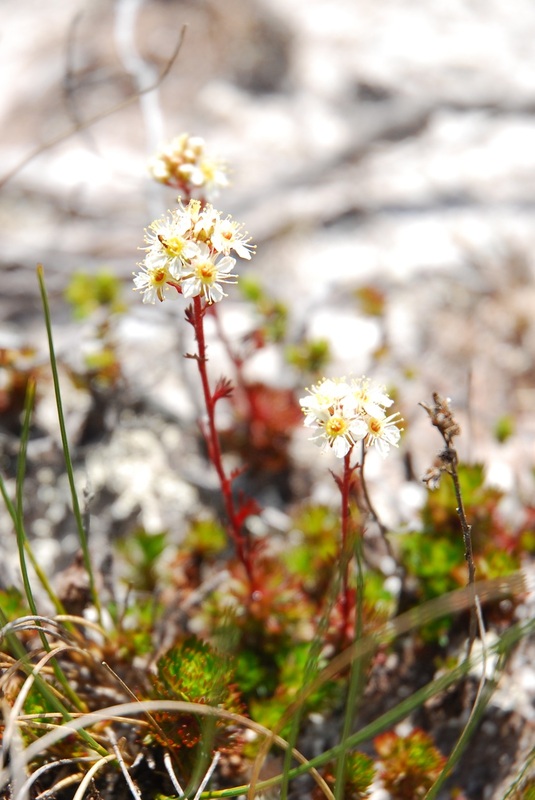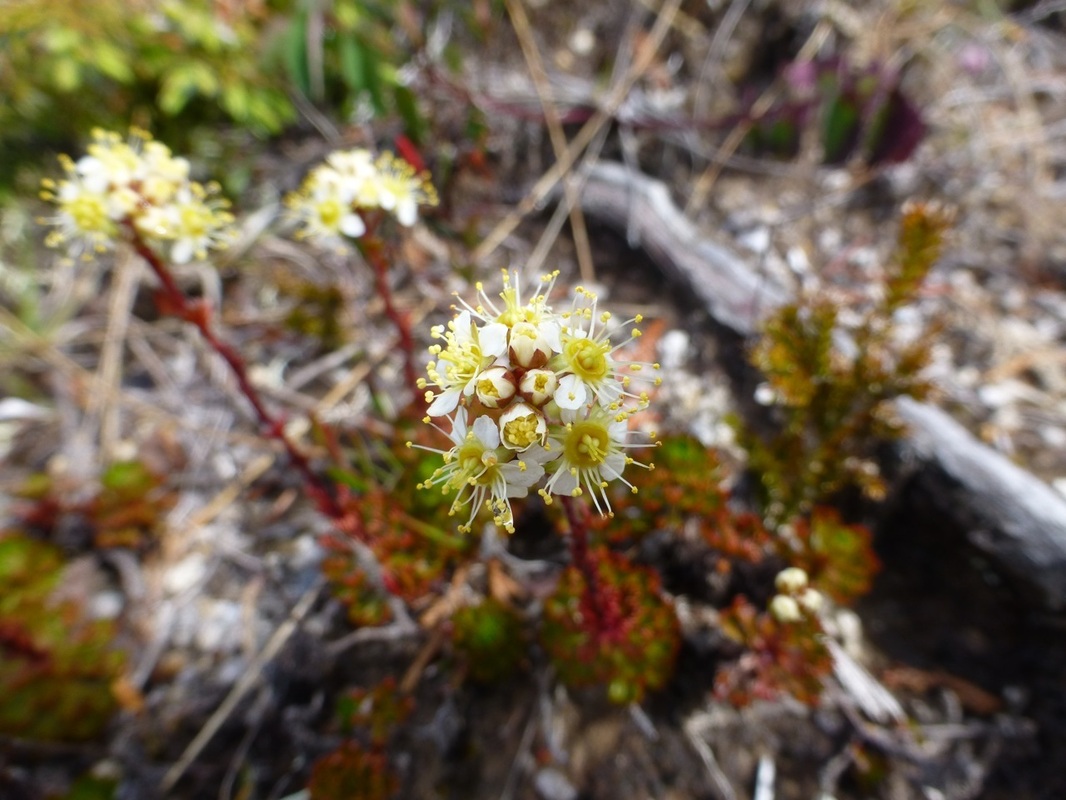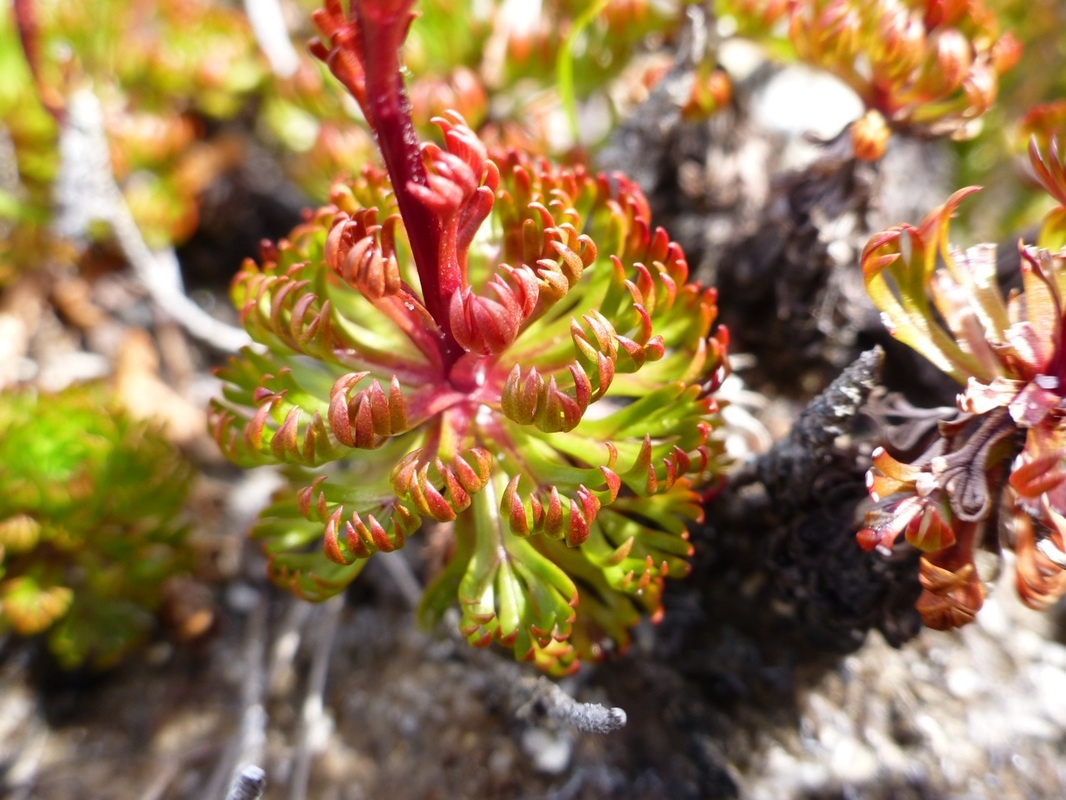Partridgefoot • Luetkea pectinata
{Luetkea = for early 19th century Russian captain/explorer Count F.P. Lütke who mapped the Alaskan coastline; pectinata = pectinate, in reference to the dissected leaves which resemble the teeth of a comb}
Identification
Partridgefoot is a evergreen semi-shrub that forms mats with individuals connected via rhizomes and stolons. Its flowering stems grow upright or ascending to 15 cm tall. Most of its leaves take the form of thick tufts of fan-shaped basal leaves - these leaves are persistent for multiple years. The stem leaves are small and alternate along the stem; both stem and basal leaves are dissected into three's 2 or 3 times. The small white flowers appear in a dense cluster at the top of the stem. The fruits are short and hairy, with distinctive elongated S-shaped styles.
Habitat & Range
Partridgefoot grows in meadows, heath, scree slopes, mossy seepages, and tundra from middle to alpine elevations. It is a very common alpine plant throughout most of BC, and is found throughout most of western North America from Alaska to northern California and east to the Northwest Territories, Alberta, Idaho, and Montana.
Intriguing Info
The status of semi-shrub, or 'subshrub,' is because partridgefoot has a woody root-stalk which is too short for 'shrub' classification, while the woody aspect excludes it from the 'herb' category. Partridgefoot is a member of the rose family (Rosaceae), and is the only member of its genus.
Partridgefoot is a evergreen semi-shrub that forms mats with individuals connected via rhizomes and stolons. Its flowering stems grow upright or ascending to 15 cm tall. Most of its leaves take the form of thick tufts of fan-shaped basal leaves - these leaves are persistent for multiple years. The stem leaves are small and alternate along the stem; both stem and basal leaves are dissected into three's 2 or 3 times. The small white flowers appear in a dense cluster at the top of the stem. The fruits are short and hairy, with distinctive elongated S-shaped styles.
Habitat & Range
Partridgefoot grows in meadows, heath, scree slopes, mossy seepages, and tundra from middle to alpine elevations. It is a very common alpine plant throughout most of BC, and is found throughout most of western North America from Alaska to northern California and east to the Northwest Territories, Alberta, Idaho, and Montana.
Intriguing Info
The status of semi-shrub, or 'subshrub,' is because partridgefoot has a woody root-stalk which is too short for 'shrub' classification, while the woody aspect excludes it from the 'herb' category. Partridgefoot is a member of the rose family (Rosaceae), and is the only member of its genus.
References
Fertig, W. Partridge-foot (Luetkea pectinata). Plant of the Week. USDA Forest Service. Accessed 15/07/2014.
Pojar, J. and MacKinnon, A. (1994). Plants of Coastal British Columbia, Revised. Vancouver, BC: Lone Pine Publishing. P. 184.
Luetkea pectinata (Pursh) Kuntze. In Klinkenberg, Brian. (Ed.). E-Flora BC: Electronic Atlas of the Plants of British Columbia. Lab for Advanced Spatial Analysis, Department of Geography, University of British Columbia, Vancouver. Accessed 15/07/2013.
Authors and editors of page
Kelly Fretwell and Brian Starzomski (2014).
Fertig, W. Partridge-foot (Luetkea pectinata). Plant of the Week. USDA Forest Service. Accessed 15/07/2014.
Pojar, J. and MacKinnon, A. (1994). Plants of Coastal British Columbia, Revised. Vancouver, BC: Lone Pine Publishing. P. 184.
Luetkea pectinata (Pursh) Kuntze. In Klinkenberg, Brian. (Ed.). E-Flora BC: Electronic Atlas of the Plants of British Columbia. Lab for Advanced Spatial Analysis, Department of Geography, University of British Columbia, Vancouver. Accessed 15/07/2013.
Authors and editors of page
Kelly Fretwell and Brian Starzomski (2014).






